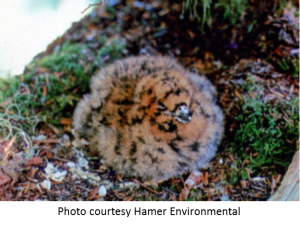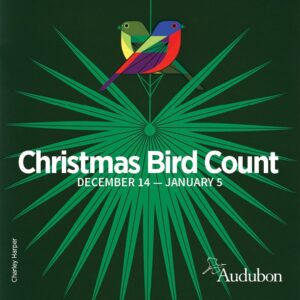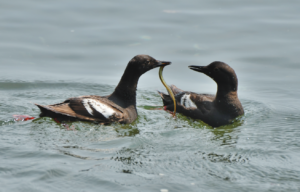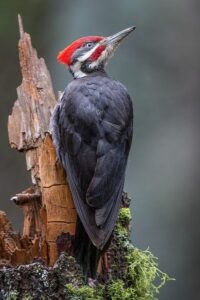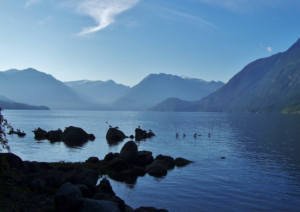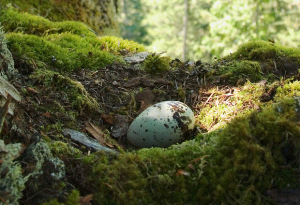 Marbled Murrelets spend the winter off shore and, in Washington, begin moving inland in March to nest. For a month, the parents take turns incubating their egg, changing places every 24 hours at dawn. While one parent sits on the egg (the size of a chicken’s egg), the other forages at sea.
Marbled Murrelets spend the winter off shore and, in Washington, begin moving inland in March to nest. For a month, the parents take turns incubating their egg, changing places every 24 hours at dawn. While one parent sits on the egg (the size of a chicken’s egg), the other forages at sea.
After the downy chick hatches, it is brooded for a few days, then left alone on its nest. Its parents return only briefly—as many as eight times a day to deliver fish for their chick to swallow whole and headfirst. The chick remains on the nest for a month and then molts its camouflaging brown plumage to reveal its striking black-and-white juvenal feathers.
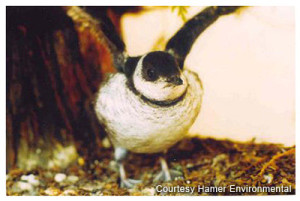 A young Murrelet seems to fledge on instinct alone. Without practice flights or guidance from parents or peers, it leaves its nest at sunset and flies to the ocean alone to begin its life at sea. Marbled Murrelets begin breeding around age three. They are long lived species, with an estimated lifespan of 15 years, though they do not breed every year.
A young Murrelet seems to fledge on instinct alone. Without practice flights or guidance from parents or peers, it leaves its nest at sunset and flies to the ocean alone to begin its life at sea. Marbled Murrelets begin breeding around age three. They are long lived species, with an estimated lifespan of 15 years, though they do not breed every year.
Need for Big Old Trees
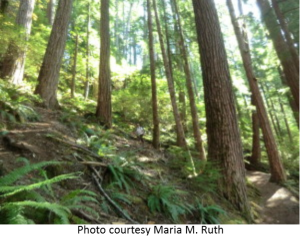 Marbled Murrelets need wide platforms upon which to land and lay their egg. Ideally, these platforms are at least 50 feet off the ground and out of reach of land-based predators. These platforms are most commonly found in the live crowns of mature and old-growth trees in our coastal forests.
Marbled Murrelets need wide platforms upon which to land and lay their egg. Ideally, these platforms are at least 50 feet off the ground and out of reach of land-based predators. These platforms are most commonly found in the live crowns of mature and old-growth trees in our coastal forests.
Depending on which property owner or agency you consult (and in what decade), these forests are also described as “mature,” “old,” “older,” or “late successional” forests. Sometimes they are referred to poetically as “virgin” or “primeval” forests. Not until the late 20th century did a definition of “old-growth” forests emerge. Scientists generally agree that an old-growth forest is “of a certain age” (at least 80 years old) and is dominated by very large trees—though their diameter and height vary with species, latitude, and elevation. Such forests are also characterized by a multi-layered and multispecies canopy, large trees with broken tops, snags, and downed logs.
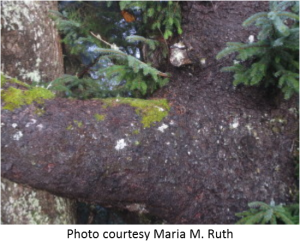 Such forests are biologically diverse, aesthetically beautiful, and iconic of the Pacific Northwest. They provide habitat to numerous other species and also offer benefits we may take for granted. These benefits, increasingly referred to as “ecosystem service,” include providing clean air and pure water, sequestering carbon, regenerating nutrients, preventing soil erosion, and mitigating storm-water surges.
Such forests are biologically diverse, aesthetically beautiful, and iconic of the Pacific Northwest. They provide habitat to numerous other species and also offer benefits we may take for granted. These benefits, increasingly referred to as “ecosystem service,” include providing clean air and pure water, sequestering carbon, regenerating nutrients, preventing soil erosion, and mitigating storm-water surges.
Most importantly right now, these forests provide the nesting habitat the Marbled Murrelet depends on for its survival. Saving this marvelous seabird means we must work together to protect both the forest habitat where it nests and the oceans where it forages.


